key Oldsmobile Achieva 1997 s Owner's Guide
[x] Cancel search | Manufacturer: OLDSMOBILE, Model Year: 1997, Model line: Achieva, Model: Oldsmobile Achieva 1997Pages: 372, PDF Size: 18.52 MB
Page 125 of 372
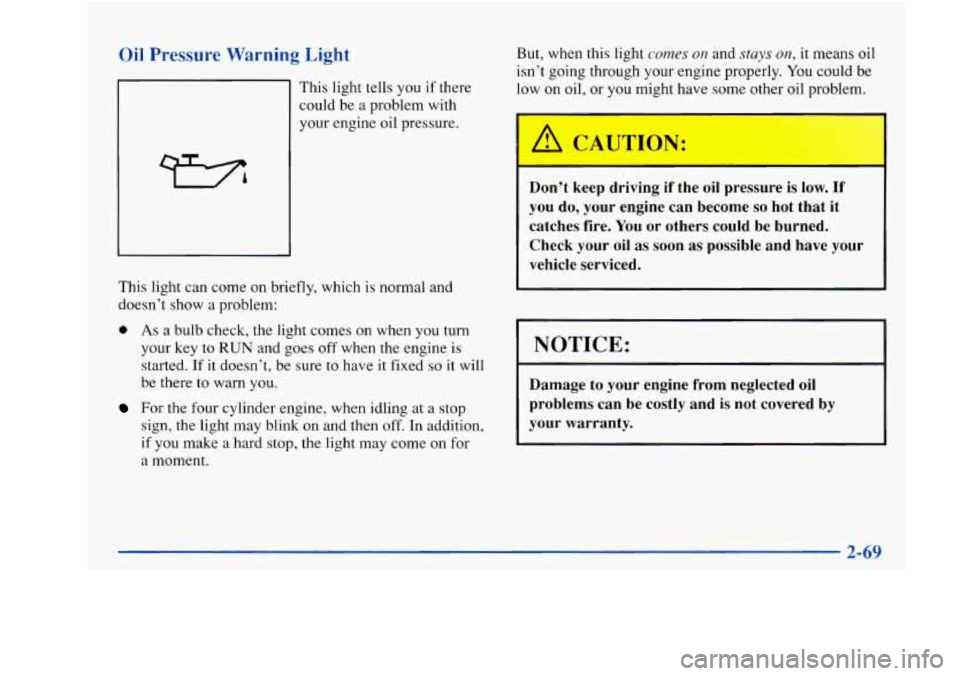
Oil Pressure Warning Light
This light tells you if there
could be a problem with
your engine oil pressure.
This light can come on briefly, which is normal and
doesn’t show a problem:
0 As a bulb check, the light comes on when you turn
your key
to RUN and goes off when the engine is
started. If it doesn’t, be sure to have it fixed so it will
be there
to warn you.
For the four cylinder engine, when idling at a stop
sign, the light may blink on and then off. In addition,
if you make
a hard stop, the light may come on for
a moment.
But, when this light comes on and stays on, it means oil
isn’t going through your engine properly.
You could be
low on oil, or you might have some other oil problem.
Don’t keep driving
if the oil pressure is low. If
you do, your engine can become so hot that it
catches fire.
You or others could be burned.
Check your oil
as soon as possible and have your
vehicle serviced.
NOTICE:
Damage to your engine from neglected oil
problems can be costly and
is not covered by
your warranty.
Page 126 of 372
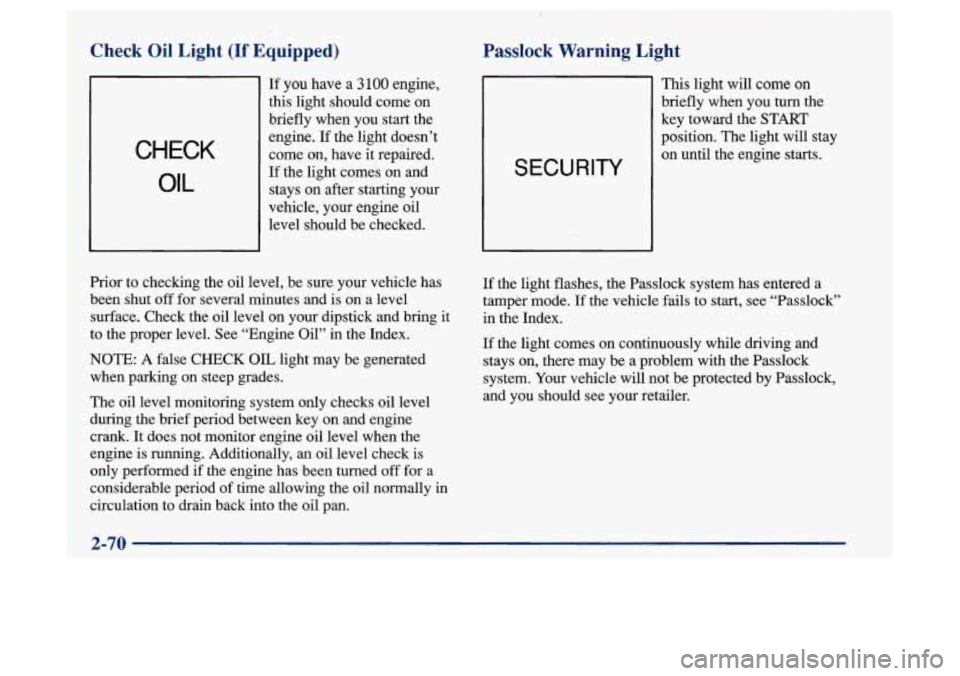
Check Oil Light (If Equipped) Passlock Warning Light
CHECK
OIL
If you have a 3 100 engine,
this light should come on
briefly when you start the
engine.
If the light doesn’t
come on, have it repaired.
If the light comes on and
stays on after starting your
vehicle, your engine oil
level should be checked. SECURITY
This light will come on
briefly when you turn the
key toward the START
position. The light will stay
on until the engine starts.
Prior to checking the oil level, be sure your vehicle has
been shut off for several minutes and is on a level
surface. Check the oil level on your dipstick and bring it
to the proper level. See “Engine Oil” in the Index.
NOTE:
A false CHECK OIL light may be generated
when parking on steep grades.
The
oil level monitoring system only checks oil level
during the brief period between key on and engine
crank. It does not monitor engine oil level when the
engine is running. Additionally, an oil level check is
only performed if the engine has been turned off for a
considerable period of time allowing the oil normally in
circulation to drain back into the oil pan.
If the light flashes, the Passlock system has entered a
tamper mode,
If the vehicle fails to start, see “Passlock”
in the Index.
If the light comes on continuously while driving and
stays on, there may be a problem with the Passlock
system. Your vehicle will not be protected by Passlock,
and you should see your retailer.
2-70
Page 157 of 372
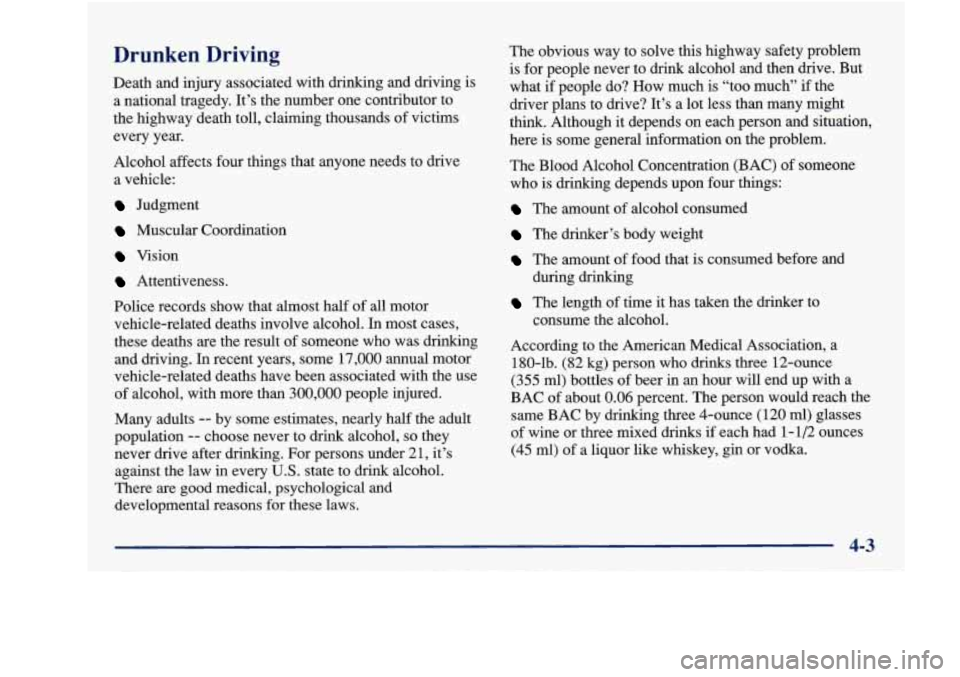
Drunken Driving
Death and injury associated with drinking and driving is
a national tragedy. It’s the number one contributor to
the highway death toll, claiming thousands of victims
every year.
Alcohol affects four things that anyone needs to drive
a vehicle:
Judgment
Muscular Coordination
Vision
Attentiveness.
Police records show that almost half of all motor
vehicle-related deaths involve alcohol.
In most cases,
these deaths are the result of someone who was drinking
and driving.
In recent years, some 17,000 annual motor
vehicle-related deaths have been associated with the use
of alcohol, with more than 300,000 people injured.
Many adults
-- by some estimates, nearly half the adult
population
-- choose never to drink alcohol, so they
never drive after drinking. For persons under 2
1, it’s
against the law
in every U.S. state to drink alcohol.
There are good medical, psychological and
developmental reasons for these laws. The
obvious way to solve this highway safety problem
is for people never to drink alcohol and then drive. But
what
if people do? How much is “too much” if the
driver plans to drive? It’s a lot less than many might
think. Although
it depends on each person and situation,
here
is some general lnformation on the problem.
The Blood Alcohol Concentration (BAC) of someone
who is drinking depends upon four things:
The amount of alcohol consumed
The drinker’s body weight
The amount of food that is consumed before and
during drinking
consume the alcohol.
The length of time it has taken the drinker to
According to the American Medical Association, a
180-lb.
(82 kg) person who drinks three 12-ounce
(355 ml) bottles of beer in an hour will end up with a
BAC of about
0.06 percent. The person would reach the
same BAC by drinking three 4-ounce (120 ml) glasses
of wine or three mixed drinks
if each had 1 - 1/2 ounces
(45 ml) of a liquor like whiskey, gin or vodka.
Page 185 of 372
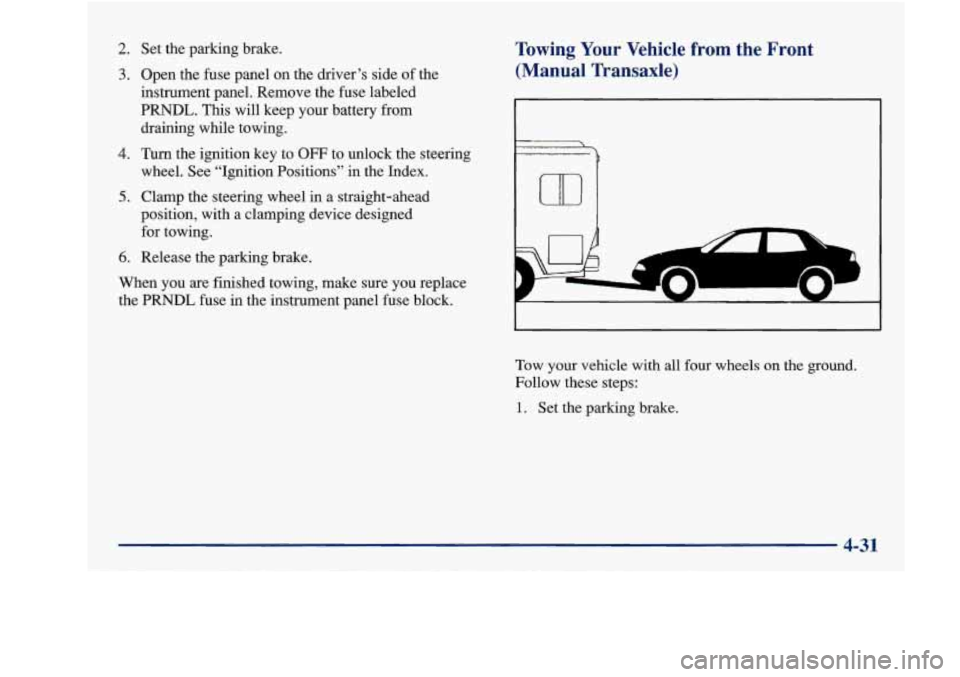
2. Set the parking brake.
3. Open the fuse panel on the driver’s side of the
instrument panel. Remove the fuse labeled
PRNDL. This will keep your battery from
draining while towing.
4. Turn the ignition key to OFF to unlock the steering
wheel. See “Ignition Positions” in the Index.
5. Clamp the steering wheel in a straight-ahead
position, with a clamping device designed
for towing.
6. Release the parking brake.
When you are finished towing, make sure you replace
the PRNDL fuse in the instrument panel fuse block.
Towing Your Vehicle from the Front
(Manual Transaxle)
P
m
nA
Tow your vehicle with all four wheels on the ground.
Follow these steps:
1. Set the parking brake.
4-31
Page 186 of 372
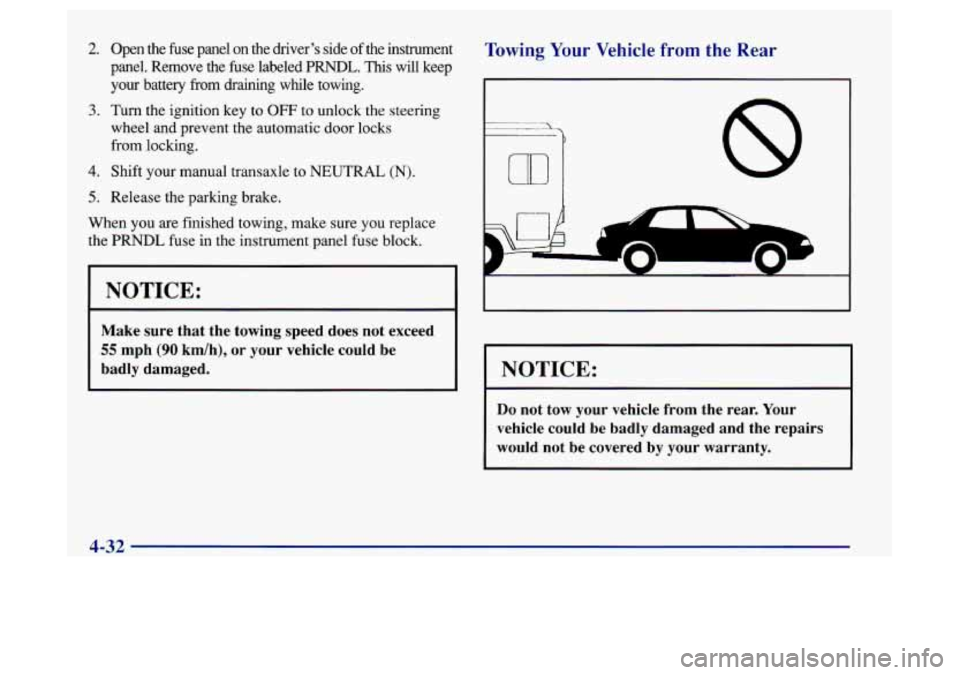
2.
3.
4.
5.
Open the fuse panel on the driver’s side of the instrument
panel. Remove the fuse labeled
PRNDL. This will keep
your battery
from draining while towing.
Turn the ignition key to
OFF to unlock the steering
wheel and prevent the automatic door locks
from locking.
Shift your manual transaxle to NEUTRAL
(N).
Release the parking brake.
When you are finished towing, make sure you replace
the
PRNDL fuse in the instrument panel fuse block.
I NOTICE:
Make sure that the towing speed does not exceed
55 mph (90 km/h), or your vehicle could be
badly damaged.
Towing Your Vehicle from the Rear
m 8
I NOTICE:
Do not tow your vehicle from the rear. Your
vehicle could be badly damaged and the repairs
would not be covered by your warranty.
4-32
Page 198 of 372
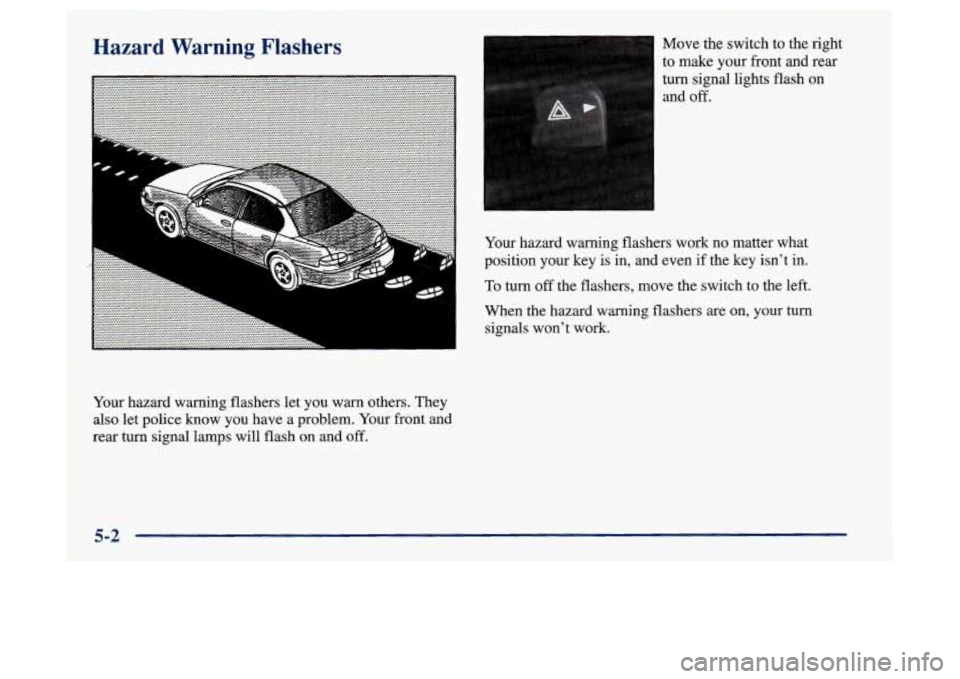
Hazard Warning Flashers
Your hazard warning flashers let you warn others. They
also let police know you have a problem. Your front and
rear turn signal lamps will flash on and
off.
Move the switch to the right
to make your front and rear
turn signal lights flash on
and off.
Your hazard warning flashers work no matter what
position your key
is in, and even if the key isn't in.
To turn off the flashers, move the switch to the left.
When the hazard warning flashers
are on, your turn
signals won't work.
5-2
Page 205 of 372
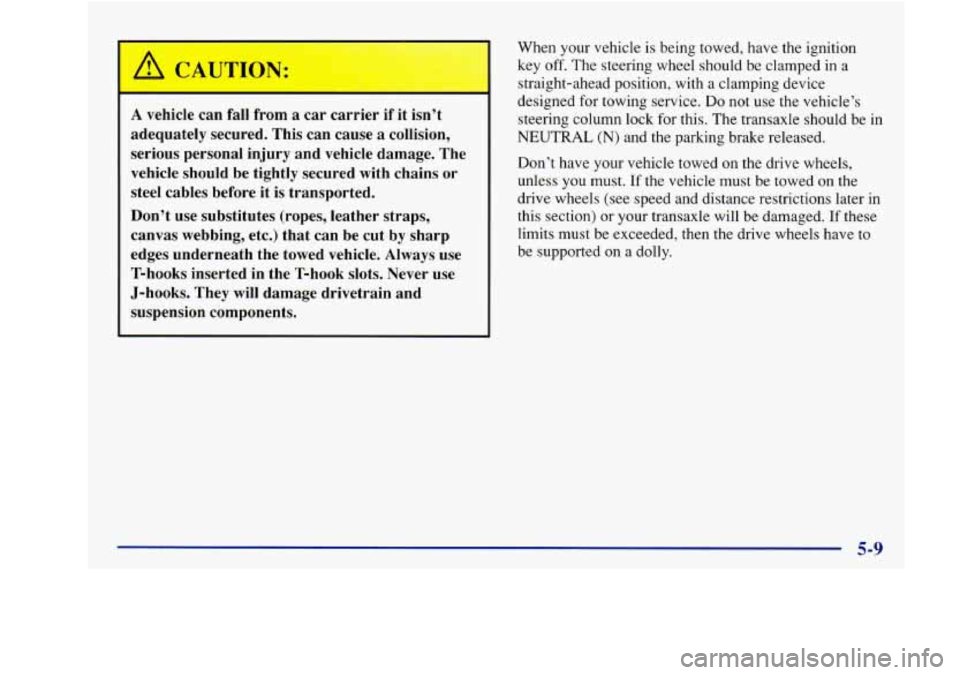
I /A CAUTION:
r
A vehicle can fall from a car carrier if it isn’t
adequately secured. This can cause
a collision,
serious personal injury and vehicle damage. The
vehicle should be tightly secured with chains or
steel cables before it
is transported.
Don’t use substitutes (ropes, leather straps,
canvas webbing, etc.) that can be cut
by sharp
edges underneath the towed vehicle. Always use
T-hooks inserted in the T-hook slots. Never use
J-hooks. They will damage drivetrain and
suspension components. When your
vehicle is being towed, have the ignition
key off. The steering wheel should be clamped
in a
straight-ahead position, with a clamping device
designed for towing service.
Do not use the vehicle’s
steering column lock for this. The transaxle should be in
NEUTRAL (N) and the parking brake released.
Don’t have your vehicle towed
on the drive wheels,
unless you must. If the vehicle must be towed on the
drive wheels (see speed and distance restrictions later in
this section) or your transaxle will be damaged. If these
limits must be exceeded, then the drive wheels have to
be supported on a dolly.
Page 336 of 372
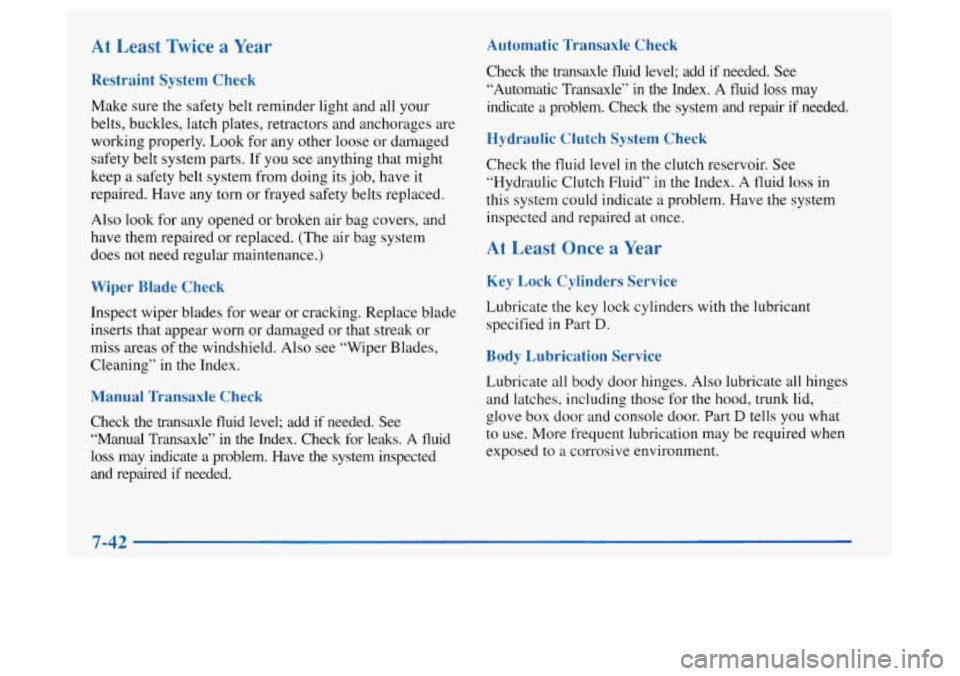
At Least Twice a Year
Restraint System Check
Make sure the safety belt reminder light and all your
belts, buckles, latch plates, retractors and anchorages are
working properly. Look for any other loose or damaged
safety belt system parts. If you see anything that might
keep a safety belt system from doing its job, have it
repaired. Have any torn or frayed safety belts replaced.
Also look for any opened or broken air bag covers, and
have them repaired or replaced. (The air bag system
does not need regular maintenance.)
Wiper Blade Check
Inspect wiper blades for wear or cracking. Replace blade
inserts that appear worn or damaged or that streak or
miss areas of the windshield. Also see “Wiper Blades,
Cleaning” in
the Index.
Manual Transaxle Check
Check the transaxle fluid level; add if needed. See
“Manual Transaxle”
in the Index. Check for leaks. A fluid
loss may indicate a problem. Have the system inspected
and repaired if needed.
Automatic Transaxle Check
Check the transaxle fluid level; add if needed. See
“Automatic Transaxle” in the Index.
A fluid loss may
indicate a problem. Check the system and repair
if needed.
Hydraulic Clutch System Check
Check the fluid level in the clutch reservoir. See
“Hydraulic Clutch Fluid” in the Index. A fluid
loss in
this system could indicate a problem. Have the system
inspected and repaired at once.
At Least Once a Year
Key Lock Cylinders Service
Lubricate the key lock cylinders with the lubricant
specified in Part
D.
Body Lubrication Service
Lubricate all body door hinges. Also lubricate all hinges
and latches, including those for the hood, trunk lid,
glove box door and console door. Part
D tells you what
to use. More frequent lubrication may be required when
exposed to a corrosive environment.
7-42
Page 337 of 372
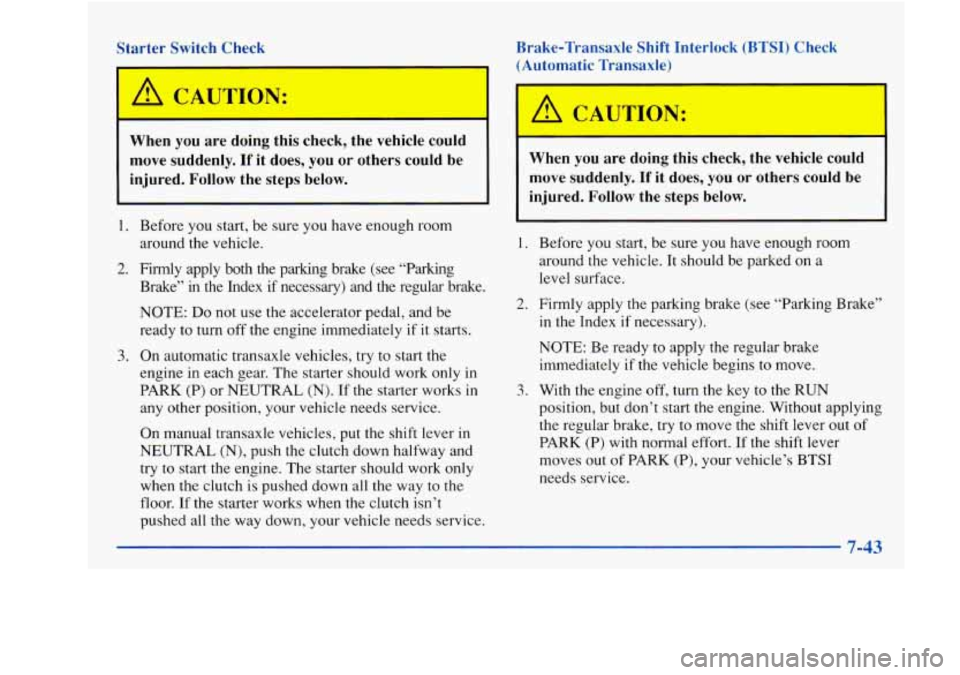
Starter Switch Check
When you are doing this check, the vehicle could
move suddenly. If it does, you or others could be
injured. Follow the steps below.
1. Before you start, be sure you have enough room
2. Firmly apply both the parking brake (see “Parking around the
vehicle.
Brake”
in the Index if necessary) and the regular brake.
NOTE:
Do not use the accelerator pedal, and be
ready to turn off the engine immediately if it starts.
3. On automatic transaxle vehicles, try to start the
engine in each gear. The starter should work only in
PARK
(P) or NEUTRAL (N). If the starter works in
any other position, your vehicle needs service.
On manual transaxle vehicles, put the shift lever in
NEUTRAL
(N), push the clutch down halfway and
try to start the engine. The starter should work only
when the clutch
is pushed down all the way to the
floor.
If the starter works when the clutch isn’t
pushed all the way down, your vehicle needs service.
Brake-Transaxle Shift Interlock (BTSI) Check
(Automatic Transaxle)
I
When you are doing this check, the vehicle could
move suddenly.
If it does, you or others could be
injured. Follow the steps below.
1. Before you start, be sure you have enough room
around the vehicle. It should be parked
on a
level surface.
2. Firmly apply the parking brake (see “Parking Brake”
in the Index if necessary).
NOTE: Be ready to apply the regular brake
immediately
if the vehicle begins to move.
3. With the engine off, turn the key to the RUN
position, but don’t start
the engine. Without applying
the regular brake, try to move the shift lever out of
PARK (P) with normal effort. If the shift lever
moves out of PARK (P), your vehicle’s
BTSI
needs service.
7-43
Page 338 of 372
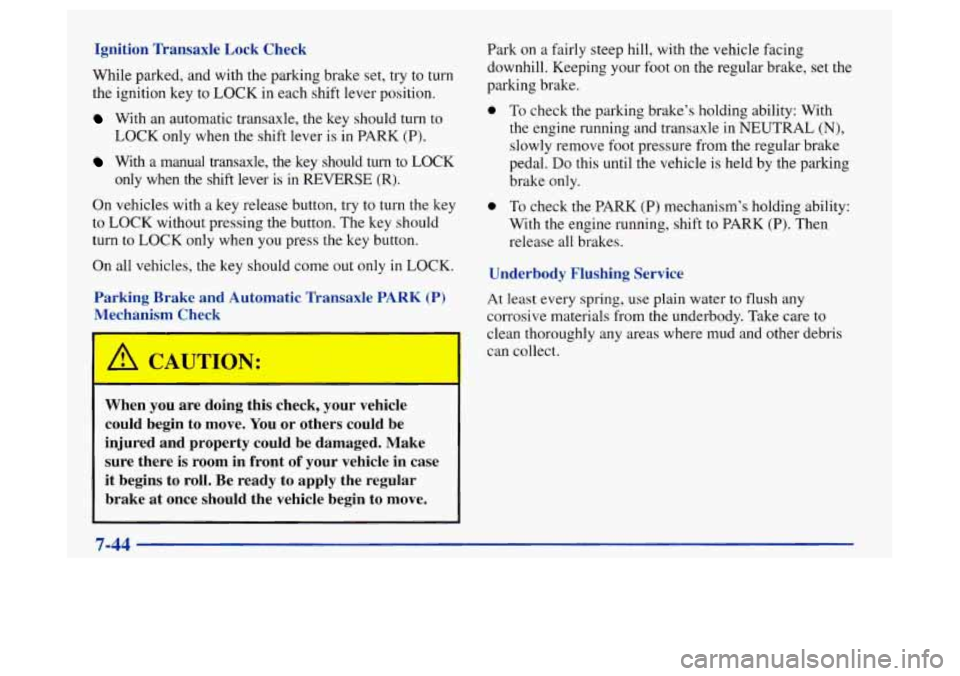
Ignition Transaxle Lock Check
While parked, and with the parking brake set, try to turn
the ignition key to LOCK in each shift lever position.
With an automatic transaxle, the key should turn to
LOCK only when the shift lever is in PARK (P).
With a manual transaxle, the key should turn to LOCK
only when the shift lever is in REVERSE (R).
On vehicles with
a key release button, try to turn the key
to
LOCK without pressing the button. The key should
turn to
LOCK only when you press the key button.
On all vehicles, the key should come out only
in LOCK.
Parking Brake and Automatic Transaxle PARK (P)
Mechanism Check
When you are doing this check, your vehicle
could begin
to move. You or others could be
injured and property could be damaged. Make
sure there
is room in front of your vehicle in case
it begins to roll. Be ready to apply the regular
brake at once should the vehicle begin to move. Park
on a fairly steep hill, with the vehicle facing
downhill. Keeping your foot
on the regular brake, set the
parking brake.
0
0
To check the parking brake’s holding ability: With
the engine running and transaxle in NEUTRAL
(N),
slowly remove foot pressure from the regular brake
pedal.
Do this until the vehicle is held by the parking
brake only.
To check the PARK (P) mechanism’s holding ability:
With the engine running, shift to PARK
(P). Then
release all brakes.
Underbody Flushing Service
At least every spring, use plain water to flush any
corrosive materials from the underbody. Take care to
clean thoroughly any areas where mud and other debris
can collect.
7-44